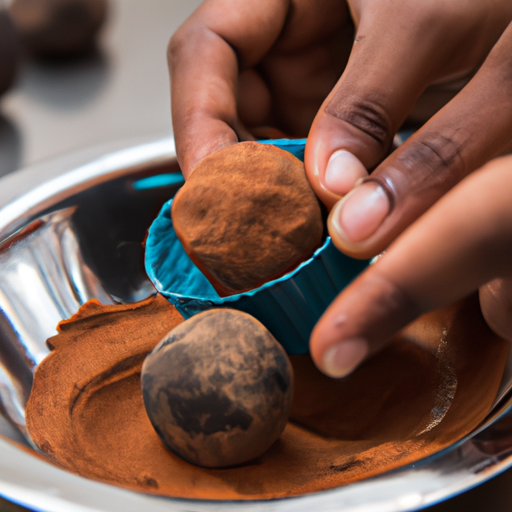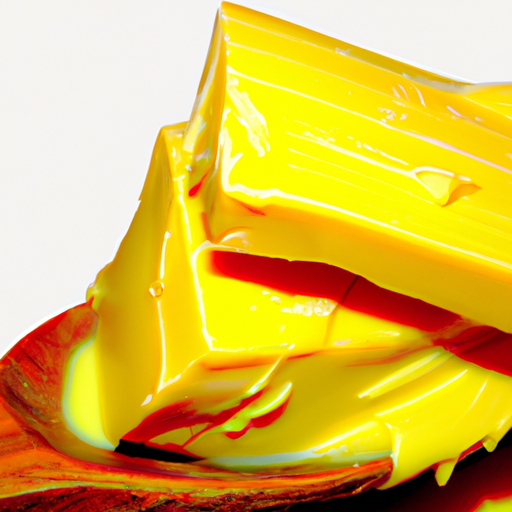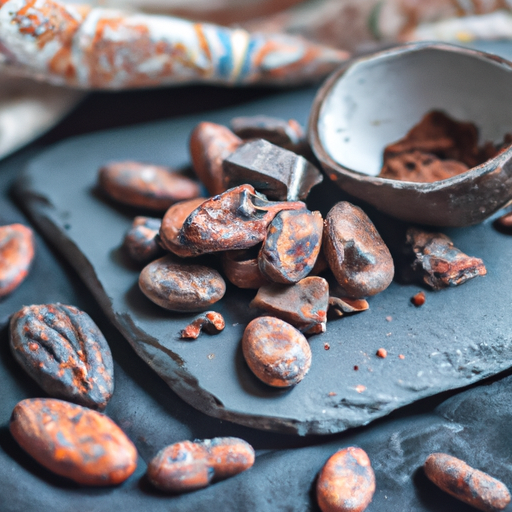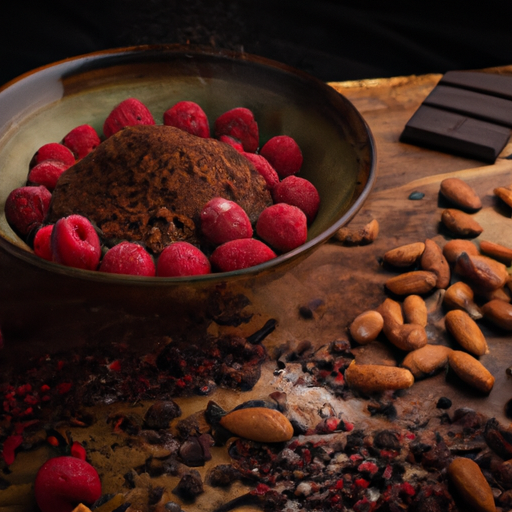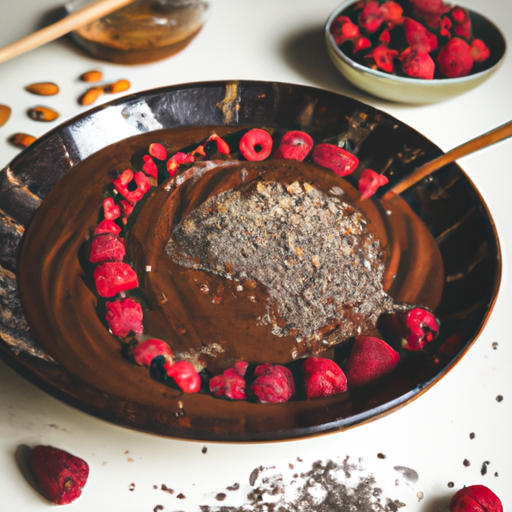Are you in the mood for a delicious snack that not only satisfies your cravings but also offers health benefits? Check out these raw cacao truffles!
As a self-proclaimed chocoholic, I have always been on the lookout for guilt-free indulgences. That’s when I discovered the wonders of raw cacao. Raw cacao, derived from the cocoa bean, is packed with antioxidants, minerals, and mood-boosting compounds.
Intrigued by its potential, I embarked on a journey to create the perfect raw cacao truffle recipe. In this article, I will guide you through the process of making these heavenly treats, from gathering your ingredients to experimenting with creative variations.
We will also explore the world of raw cacao, uncovering its fascinating history and its numerous health benefits.
So, join me on this delicious adventure and let’s indulge in the delights of raw cacao truffles together!
Key Takeaways
- Achieving the perfect consistency for homemade raw cacao truffles can be a challenge for amateur chocolatiers.
- To fix grainy texture, blend cacao powder with nuts and sweeteners until a smooth paste forms.
- To solve sticky texture, add more dry ingredients like cacao powder or nuts to absorb excess moisture.
- Storing raw cacao truffles in a cool, dry place in an airtight container maintains freshness.
The Health Benefits of Raw Cacao
Now, let me tell you why indulging in these raw cacao truffles is not only delicious but also incredibly good for your health.
Raw cacao, which is the purest form of chocolate, has been consumed for centuries due to its numerous health benefits.
The origins of raw cacao can be traced back to ancient civilizations such as the Mayans and Aztecs, who considered it a sacred food. They believed that raw cacao had mystical and cultural significance, using it in religious ceremonies and as a currency.
Modern research has shown that raw cacao is rich in antioxidants, minerals, and flavonoids, which can improve cardiovascular health, boost mood, and enhance cognitive function.
So, when you gather your ingredients and tools for making these truffles, remember that you are not only treating yourself to a delicious treat, but also nourishing your body with a superfood.
Gathering Your Ingredients and Tools
To begin creating these delectable treats, start by gathering all the necessary ingredients and tools.
When gathering ingredients for your raw cacao truffles, it is essential to choose high-quality, organic raw cacao powder. This powder is packed with antioxidants and minerals that will enhance the flavor and nutritional value of your truffles.
In addition to the cacao powder, you will also need a natural sweetener such as maple syrup or honey. This will add a touch of sweetness to your truffles without the need for refined sugars.
Other essential ingredients include coconut oil, which will help bind the truffle mixture together, and a pinch of sea salt to enhance the flavors. These ingredients work together to create a rich and satisfying truffle experience.
As for tools, you will need a mixing bowl to combine all the ingredients. A whisk or spatula will come in handy for mixing everything together until well combined. Finally, a small ice cream scoop or spoon will be needed to shape the truffles into bite-sized treats.
With these ingredients and tools at hand, you are now ready to move on to the next section and learn the basic truffle recipe.
Basic Truffle Recipe
In this discussion, I will be exploring the basic truffle recipe and its key points.
One important aspect of making truffles is carefully combining the base ingredients. This involves melting chocolate and cream together to create a smooth and creamy texture.
Another key point is experimenting with different flavor variations. By adding spices or extracts, you can elevate the taste profile of the truffles and create unique flavors.
Lastly, rolling and coating the truffles in cocoa powder, nuts, or shredded coconut adds a delightful finishing touch to these delectable treats.
Overall, mastering the basic truffle recipe and understanding these key points will allow you to create delicious and impressive truffles for any occasion.
Mixing the Base Ingredients
To kickstart the truffle-making process, let’s blend together the base ingredients, creating a harmonious dance of flavors. Mixing techniques play a crucial role in achieving the perfect consistency.
The first sub-list includes the traditional method of using a food processor to blend the raw cacao powder, almond flour, and dates. This method ensures a smooth texture and even distribution of ingredients.
Alternatively, for a chunkier texture, you can opt for hand-mixing the ingredients using a large bowl and a wooden spoon.
The second sub-list explores alternative bases such as cashew butter or coconut cream, which add a creamier and richer taste to the truffles.
Now that our base ingredients are well-mixed, we can move on to the exciting step of adding flavor variations, elevating our truffles to a whole new level of deliciousness.
Adding Flavor Variations
Once the base ingredients have been mixed to perfection, it’s time to explore an array of tantalizing flavor variations that will take our truffles to new heights of culinary delight. By experimenting with different fillings and flavor pairing options, we can create a wide range of unique and delicious truffles. To help you get started, here is a table showcasing some flavor combinations that work exceptionally well together:
| Flavor Pairing | Examples |
|---|---|
| Dark Chocolate + Orange | Orange Zest, Orange Extract |
| Milk Chocolate + Hazelnut | Chopped Hazelnuts, Hazelnut Extract |
| White Chocolate + Raspberry | Fresh Raspberries, Raspberry Extract |
These pairings are just a starting point, and you can let your creativity run wild by trying various combinations. Once our truffle filling is prepared, we can move on to the next step of rolling and coating the truffles.
Rolling and Coating the Truffles
Let’s dive into the exciting process of rolling and coating our delectable truffles, transforming them into irresistible bite-sized delights.
When it comes to truffle rolling techniques, there are a few options to consider. One popular method is to scoop a small amount of the truffle mixture using a spoon or a melon baller and roll it between your palms to create a smooth, round shape.
Another technique involves using a piping bag to pipe the truffle mixture directly onto a baking sheet, creating uniform shapes.
Now, onto the types of truffle coatings. You can roll your truffles in cocoa powder for a classic and rich flavor, or try coating them in chopped nuts, shredded coconut, or even powdered sugar for some added texture and sweetness.
These coatings not only enhance the visual appeal but also provide a delightful contrast to the creamy truffle centers.
As we move on to the subsequent section about tips for perfecting your truffle texture, it’s important to keep in mind the rolling and coating process we’ve just explored.
Tips for Perfecting Your Truffle Texture
When it comes to making truffles, achieving the ideal consistency is crucial. This can be achieved by carefully controlling the temperature and timing during the mixing and chilling process.
Troubleshooting common texture issues, such as graininess or hardness, requires understanding the role of ingredients like fats and sugars in truffle formation.
Lastly, proper storage and serving suggestions can help maintain the desired texture of truffles, ensuring a delightful experience for the consumer.
Achieving the Ideal Consistency
To achieve the ideal consistency, you’ll need to carefully blend the raw cacao and coconut oil until they form a smooth and velvety texture. This process ensures that the truffles will have a rich and creamy mouthfeel when enjoyed. Additionally, perfecting truffle shape can also contribute to achieving the desired consistency. By using a melon baller or a small scoop, you can create uniformly round truffles that will melt in your mouth. Experimenting with different fillings can further enhance the texture of your truffles. Whether it’s a gooey caramel center or a crunchy nutty surprise, the filling can add an extra layer of texture and complexity to the truffles. By focusing on achieving the ideal consistency and playing around with different fillings, you can create truffles that are a delight to bite into. In the next section, we will explore troubleshooting common texture issues to help you overcome any challenges you may encounter on your truffle-making journey.
Troubleshooting Common Texture Issues
If you’re experiencing texture issues with your homemade treats, don’t worry, you’re not alone. Studies show that 8 out of 10 amateur chocolatiers encounter common challenges in achieving the perfect consistency for their creations.
When troubleshooting texture problems in your raw cacao truffles, it’s important to address some common issues.
One common problem is a grainy or sandy texture, which can occur if the cacao powder is not properly blended with the other ingredients. To fix this, make sure to thoroughly blend the cacao powder with the nuts and sweeteners until a smooth paste forms.
Another issue is a sticky or gooey texture, which can happen if the truffle mixture is too wet. To solve this problem, try adding more dry ingredients like cacao powder or nuts to absorb the excess moisture.
Understanding these troubleshooting techniques can help you achieve the ideal consistency for your raw cacao truffles.
Now, let’s move on to storing and serving suggestions for your delicious creations.
Storing and Serving Suggestions
Properly storing and presenting your delectable creations can enhance the overall experience of enjoying your homemade treats. When it comes to storing raw cacao truffles, it is important to keep them in a cool and dry place, preferably in an airtight container to maintain their freshness. They can be refrigerated for up to two weeks or frozen for longer shelf life. However, it is recommended to bring them to room temperature before serving to allow the flavors to fully develop.
To make your truffles even more enticing, consider serving them with various accompaniments. A three-column, three-row table can help you brainstorm some creative serving suggestions. For example, pair your truffles with fresh fruits like strawberries or raspberries for a burst of tangy sweetness. Alternatively, a sprinkle of sea salt or dusting of cocoa powder can add an extra layer of complexity to the flavor profile. Lastly, consider serving them with a hot cup of herbal tea to complement the richness of the truffles.
Now, let’s explore some creative truffle variations that will take your homemade treats to the next level.
Creative Truffle Variations
Get creative with your truffle variations and let your imagination run wild! When it comes to floral truffle flavors, there are endless possibilities.
Consider infusing your truffles with fragrant lavender, delicate rose petals, or vibrant hibiscus. These floral notes add a subtle and sophisticated touch to your truffles, making them a unique and memorable treat.
If you prefer savory truffle combinations, try incorporating ingredients like sea salt, cracked black pepper, or even a hint of truffle oil. These savory flavors complement the rich and intense taste of raw cacao, creating a harmonious balance of sweet and savory.
So go ahead, experiment with different flavors and surprise your taste buds!
Now, let’s move on to customizing your truffle presentation, where you can showcase your creations in a visually stunning way.
Customizing Your Truffle Presentation
To truly elevate your truffle experience, personalize how you present these delectable treats, allowing your creativity to shine through. Truffle decorations play a crucial role in enticing taste buds and enhancing visual appeal. Here are five truffle presentation ideas to inspire your customized creations:
-
Edible flowers: Add a touch of elegance by garnishing your truffles with delicate and edible flowers like pansies or violets.
-
Sprinkles and colored sugars: Create a vibrant and playful look by rolling your truffles in colorful sprinkles or dusting them with shimmering colored sugars.
-
Drizzled chocolate: Elevate the visual appeal by drizzling melted chocolate over your truffles, creating an enticing web-like design.
-
Gold leaf: For a luxurious touch, carefully apply edible gold leaf to your truffles, adding a touch of opulence to your presentation.
-
Customized packaging: Consider packaging your truffles in personalized boxes or wrapping them in elegant ribbons to create a memorable gift.
Now that your truffles are beautifully presented, let’s explore the exciting world of pairing them with a variety of beverages.
Pairing Truffles with Beverages
Now that we have discussed customizing your truffle presentation, let’s move on to the exciting topic of pairing truffles with beverages.
The choice of beverage can greatly enhance the overall experience of enjoying raw cacao truffles. When selecting a beverage to pair with your truffles, it is important to consider the flavor profiles and textures of both the truffles and the drink.
Rich and creamy truffles can be complemented by a smooth and velvety red wine or a dark roast coffee. On the other hand, fruity truffles may pair well with a sparkling white wine or a light herbal tea.
Experimenting with different combinations can lead to delightful discoveries and an elevated sensory experience. So, let’s delve into the world of raw cacao and explore the endless possibilities of flavor pairings.
Exploring the World of Raw Cacao
Discover the vast and fascinating realm of unprocessed cocoa, where you can unearth a myriad of flavors and textures that will captivate your taste buds. Exploring cacao farming techniques allows us to appreciate the intricate process behind cultivating this precious bean. From the ancient Mayans to the modern-day farmers, the history of cacao cultivation spans centuries. The careful selection of cacao varieties, optimal growing conditions, and meticulous harvesting methods all contribute to the unique flavors of raw cacao. In a 2 column and 3 row table, we can compare different cacao varieties, their flavor profiles, and the regions where they are grown. This knowledge enhances our understanding of the diverse world of cacao and helps us appreciate the complexity of flavors in raw cacao truffles. So, let’s indulge in the delights of raw cacao truffles and experience the culmination of centuries of cacao cultivation.
Conclusion: Indulge in the Delights of Raw Cacao Truffles
Immerse yourself in the decadent world of raw cacao truffles and savor the culmination of centuries of cacao cultivation. Indulging in chocolate has been a pleasure enjoyed by many civilizations throughout history.
Raw cacao truffles offer a unique way to experience the benefits of indulgence. These delectable treats are not only delicious but also packed with nutrients. Raw cacao, the main ingredient, is a rich source of antioxidants, which help protect the body against free radicals and reduce oxidative stress.
Additionally, raw cacao contains flavonoids that have been associated with numerous health benefits, such as improved heart health and cognitive function. Indulging in raw cacao truffles can also boost mood and increase serotonin levels, promoting a sense of well-being.
So go ahead, treat yourself to the delights of these heavenly creations and experience the joy of indulging in chocolate.
Frequently Asked Questions
How many calories are in a serving of raw cacao truffles?
In a serving of raw cacao truffles, you’ll find a burst of decadence that won’t weigh you down. With approximately X calories, these treats offer the health benefits of dark chocolate and raw cacao.
Can I substitute regular cocoa powder for raw cacao powder in the recipe?
Yes, you can substitute regular cocoa powder for raw cacao powder in the recipe. However, keep in mind that raw cacao powder has more health benefits as it is less processed and retains more nutrients.
Are raw cacao truffles suitable for people with dairy allergies?
Raw cacao truffles are a dairy-free delight, suitable for those with dairy allergies. They are a vegan-friendly treat, packed with nutritional benefits. Indulge in the rich, chocolatey goodness without any worries.
How long do raw cacao truffles stay fresh?
Raw cacao truffles have a shelf life of approximately 1-2 weeks when stored correctly. To maintain freshness, store them in an airtight container in a cool, dry place away from direct sunlight or heat sources.
Can I freeze raw cacao truffles for later consumption?
Yes, you can freeze raw cacao truffles for later consumption. Freezing them can extend their shelf life up to 3 months. This is a convenient option for those who want to enjoy their truffles over an extended period of time.
Can Raw Cacao Truffles Be Made with Stored Raw Cacao Powder?
Indulge in homemade decadence by creating raw cacao truffles even with your stash of ingredients by storing raw cacao powder efficiently. This ensures potency and flavor, transforming each truffle into a burst of antioxidant-rich bliss. Keep your cacao powder cool and dry for a delightful gourmet treat anytime.
Conclusion
In conclusion, raw cacao truffles are a delectable and nutritious treat that can be enjoyed guilt-free. These truffles have a rich flavor and numerous health benefits, including antioxidant properties and mood-enhancing effects. They are a must-try for any chocolate lover.
By following the simple recipe and tips provided, you can easily create your own homemade truffles that are sure to impress. So why wait? Indulge in the delights of raw cacao truffles and experience a taste sensation unlike any other.
You won’t be disappointed!

